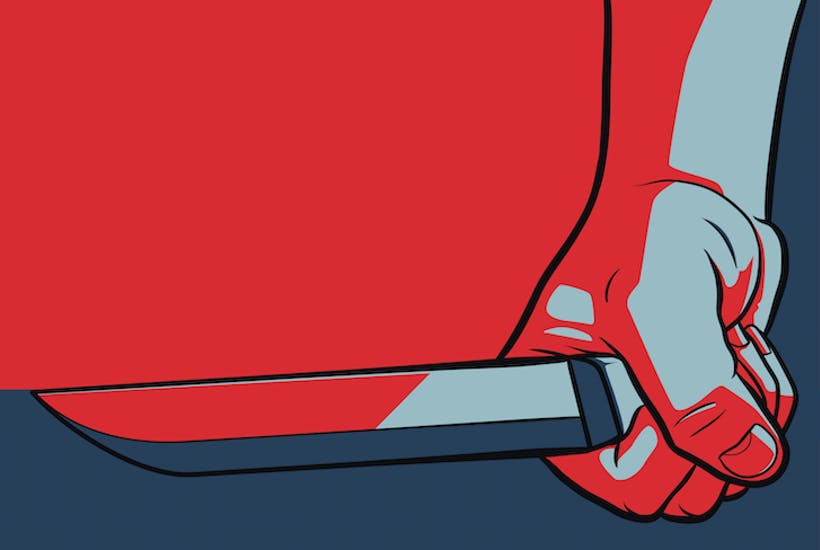What will happen when the teenagers stabbing each other on the streets of London grow up? Some will go straight, some will go to prison and some will probably follow a similar trajectory to Michael Adebolajo and Michael Adebowale. These two evolved from being minor figures on the south-east London gang scene into two of the most notorious Islamist killers in Britain, responsible for murdering Lee Rigby outside Woolwich barracks in 2013. In the aftermath of the murder, Harry Fletcher, a former assistant general secretary of the probation union Napo, explained:
“A major concern in recent years has been the crossover between criminal groups and Islamist organisations. It’s mainly gangs in Southwark and Lambeth and we’re talking about dozens, not hundreds, of members who are at risk. The Islamist groups will exploit both the gang members’ psychological and economic vulnerability.”
The gang scene to which Adebolajo and Adebowale belonged (and also Aine Davis, one of the most infamous British members of Isis) at the turn of the millennium has grown in the last decade, both geographically and ethnically. If Adebolajo and Adebowale – two men of Christian Nigerian background – can be radicalised, then imagine how much easier it will be for the Islamists to manipulate the minds of young Muslims when they grow out of street gangs but still need the camaraderie of belonging to a unit of so-called ‘soldiers’.
That’s what happened to Khuram Butt, the ringleader of last year’s London Bridge atrocity that left eight people dead and nearly fifty wounded. As a teenager growing up in east London, Butt was into gang culture and grime music before he became radicalised in his early twenties. Once an extremist, Butt tried “to reach out to children in an attempt to pass on his ideology”, a task made easier by the willingness of British broadcasters to air his views in their desperate chase for ratings. The authorities also took a benign view of Butt (despite warnings from within the Muslim community) with counter-terrorism chief Mark Rowley admitting last year that he was “prioritised in the lower echelons of our investigative work”.
France made similar errors of judgement with its Islamists, notably Mohamed Merah, who first came to the attention of the intelligence service in 2011, a year before he murdered seven people in a series of killings in southern France. For most of his 23 years, Merah wasn’t interested in Allah; fighting, thieving and football were his passions. But when he was 18, Merah and seven other youths were imprisoned for running over two policemen in a stolen vehicle. While in prison, Merah became radicalised, swapping his adolescent gang for an Islamist one, a pathway subsequently described by a former Socialist MP, Malek Boutih, as “Islamo-gangsterisme”
That Merah followed the path he did wasn’t a surprise for the historian Georges Bensoussan, whose 2002 book Les Territoires perdus de la République [The Lost Territories of the Republic] revealed the emergence of a counter-culture in France, one in which Muslim children were growing up with racist, sexist and anti-Semitic attitudes.
The book, based on interviews with teachers who had first-hand experience of the phenomenon, caused uproar and Bensoussan was ostracised from polite liberal society by people who weren’t interested in reality only the maintenance of the politically correct pretence that all was rosy in the Republic. It took the slaughter of nearly 250 people – mostly at the hands of men whose hatred had been cultivated in the milieu described in Bensoussan’s book – to drag liberals out of their cult of denial.
Britain is making the same mistakes about its own ‘lost territories’, those identified in 2016 by Dame Louise Casey in her government review. Describing the “worrying levels” of segregation within some British communities, Dame Louise warned they were fuelling Islamic extremism and she made a series of recommendations to tackle the growing problem. Last November she bemoaned the fact that her review had been “tucked away in the all-too-difficult filing cabinet and it hasn’t seen the light of day”.
The link between juvenile gangs and jihadism is undeniable; both offer young men an identity, a sense of belonging and an outlet for their insensate rage, while YouTube offers the propaganda platform on which their violence can be glamorised.
In an interview last year with the Evening Standard a former gang member called Wayne explained that the arrival in London a decade ago of Somalis and Congolese had “taught us a whole new level of violence”. He then listed the reasons for joining a gang as “power, status, girls”. The words could have come from the mouth of a Western volunteer for Isis, one of the thousands who went to the Middle East in search of what the American psychologist Arie W. Kruglanski has called ‘personal significance’. They found it not in the Koran but in kudos of being in a gang.







Comments